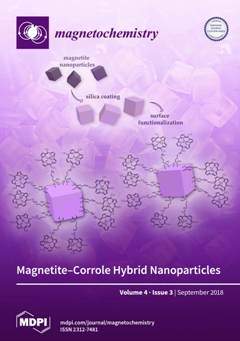The synthesis, structures and magnetic properties of a new trinuclear spin crossover complex
[FeII3(pyrtrz)6(TsO)6]·10H2O·2CH3OH (
C2) and its analogue binuclear
[FeII2(pyrtrz)5(SCN)4
[...] Read more.
The synthesis, structures and magnetic properties of a new trinuclear spin crossover complex
[FeII3(pyrtrz)6(TsO)6]·10H2O·2CH3OH (
C2) and its analogue binuclear
[FeII2(pyrtrz)5(SCN)4]·7H2O (
C1), are reported here. These two compounds are synthesized based on the
pyrrolyl functionalized Schiff base 1,2,4-triazole ligand 4-((1
H-pyrrol-2-yl)methylene-amino)-4
H-1,2,4-triazole (pyrtrz), which represent rare discrete multi-nuclear species, with
µ2-
N1,
N2-triazole bridges linking the Fe
II centers. DC magnetic susceptibility measurements revealed an abrupt single-step spin crossover (SCO) behavior for compound
2 on the central Fe
II site and single-crystal X-ray diffraction (173 K) showed that this compound crystallizes in the monoclinic space group (
P21/c), and multiple intramolecular interactions were found responsible for the abrupt transition. Compound
1 is a binuclear complex with thiocyanate as terminal ligands. This compound stays in high spin state over the whole temperature range and displays weak antiferromagnetic exchange coupling.
Full article





